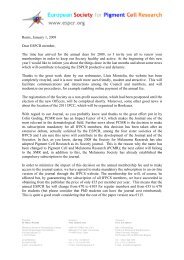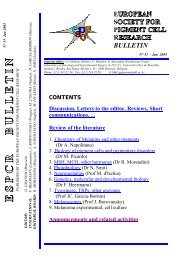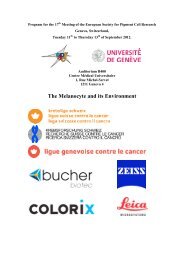espcrbulletin - European Society for Pigment Cell Research
espcrbulletin - European Society for Pigment Cell Research
espcrbulletin - European Society for Pigment Cell Research
Create successful ePaper yourself
Turn your PDF publications into a flip-book with our unique Google optimized e-Paper software.
calcium-dependent uptake of phenylalanine, both in vivo and in vitro, thus affecting the initial steps of<br />
the melanogenesis.<br />
Now, from the pathogenesis to the treatment. Tacrolimus has been succesfully used <strong>for</strong> the treatment<br />
of the vitiligo but how it works and why? Lan observes like in vitro, tacrolimus is able to act directly<br />
on keratinocytes by inducing CSF and MMP2 release. Through this mechanism it promotes<br />
melanocyte growth and proliferation and it could represent the cellular basis <strong>for</strong> the effectiveness in<br />
the treatment of the vitiligo. Falabella proposes an overview of the actual surgical methods and<br />
remarks that the appropriate selection of the patients is necessary to achieve the best results. Mulekar<br />
reports a 6-year follow-up of 142 patients treated with autologous non-cultured<br />
melanocyte/keratinocyte transplantation. He shows that the transplantation of a fresh non-cultured<br />
suspension of melanocyte/keratinocyte can give good repigmentation but the result obtained is<br />
independent of previous repigmentation in another area or test graft. It is thus possible that the disease<br />
can be active even if the lesions are apparently stable. The suggestion of Mulekar is in agreement with<br />
the idea of an intrinsic melanocyte defect which is more or less clinically evident. However, until now<br />
the panel of methods used <strong>for</strong> melanocyte or melanocyte/keratinocyte isolation is wide and the culture<br />
<strong>for</strong> in vitro or in vivo study is not univocal and obvious. Lin suggests the utilization of chitosan-coated<br />
membranes to improve the growth of the melanocytes. The chitosan-induced spheroid morphology<br />
does not affect the phenotype of the melanocytes that are able to return to the normal dendrititc<br />
morphology after the reinoculation on collagen-coated surface. The method could be useful both <strong>for</strong><br />
preliminary culture <strong>for</strong> cell transplantation in vitiligo patients and in vitro culture of melanocytes from<br />
vitiligo subjects. Hartmann per<strong>for</strong>med a trial vs placebo (four-quarters comparison) <strong>for</strong> the evaluation<br />
of the effectiveness of a combinatory therapy narrow-band UVB plus topical calcipotriol. In agreement<br />
with current literature, the authors report a higher effectiveness of the narrow-band UVB compared<br />
with broad-band UVB but they cannot indicate an improvement of UVB therapy by the topical<br />
application of calcipotriol.<br />
A lot of in vivo and in vitro evidence suggest that melanoma and vitiligo can be considered the<br />
opposite face of the same phenomenon. The understanding of vitiligo pathogenesis could represent a<br />
lesson <strong>for</strong> the approaches to the melanoma. Palermo hypothesizes that if in both diseases there is an<br />
abnormal (different degree of avidity) immune response against the same antigen, it is possible to<br />
utilize the peripheral cytotoxic melanocyte-specific TCD8 cells from vitiligo subjects <strong>for</strong> the treatment<br />
of melanoma. Obviously, a HLA compatiblity between vitiligo and melanoma patients is the crucial<br />
requisite,. The results of the in vivo trial could open a new scenario <strong>for</strong> melanoma treatment in the near<br />
future. Regarding melanoma: Tonks demonstrates a different role in vivo and in vitro <strong>for</strong> pocket<br />
proteins during proliferation of the melanocytes and progression of melanoma. A further update on the<br />
role of a-MSH and ET-1 was provided by Kadekaro. She indicates a possible intracellular pathway<br />
involving a-MSH, MC1R, Akt, CREB and Mitf and counteracting the apoptotic effect of UV. In<br />
normal melanocytes, thus, the UV-induced ET-1 production protects the cells from the apoptosis and<br />
from mutagenesis (associated with hydrogen peroxide production and DNA damage) whereas loss of<br />
function mutations of MC1R increases a risk of melanoma. An in vitro study (from a molecular<br />
approach) of the role of p53 in melanoma, paying partucular attention to its changes in stability,<br />
localization, and activity based on different DNA-damaging agents, represents the aim of the paper of<br />
Razorenova. Using two different melanoma cell lines, Mangahas shows that ET1, through ETB<br />
receptor, activates CXCL1 and CXCL8 in melanoma but not in normal melanocyte cell lines. The<br />
biological relevance is evident because ET1 downregulates e-cadherin, which inhibits the tumor<br />
invasion, and activates metalloproteinases, which promote the migration and invasion processes.<br />
Two papers sorted from PubMed are clinical studies. Guerra-Tapia describes, in a young subject, a<br />
case of vitiligo in congenital divided nevus evolving in halo nevus. The clinical pattern is interesting<br />
and requires, as suggested by the authors, a prolonged follow-up but it is improbable a common<br />
pathogenesis <strong>for</strong> vitiligo and halo nevus. The other paper is that of Loquai which describes a case of<br />
confetti-like lesions with hyperkeratosis in a 33 year old white man affected by vitiligo and mycosis<br />
fungoides. The electron microscopy and the histology corroborate a different entity <strong>for</strong> the confetti-like<br />
spots compared to the white vitiligo lesions in the same subjects.<br />
1413







